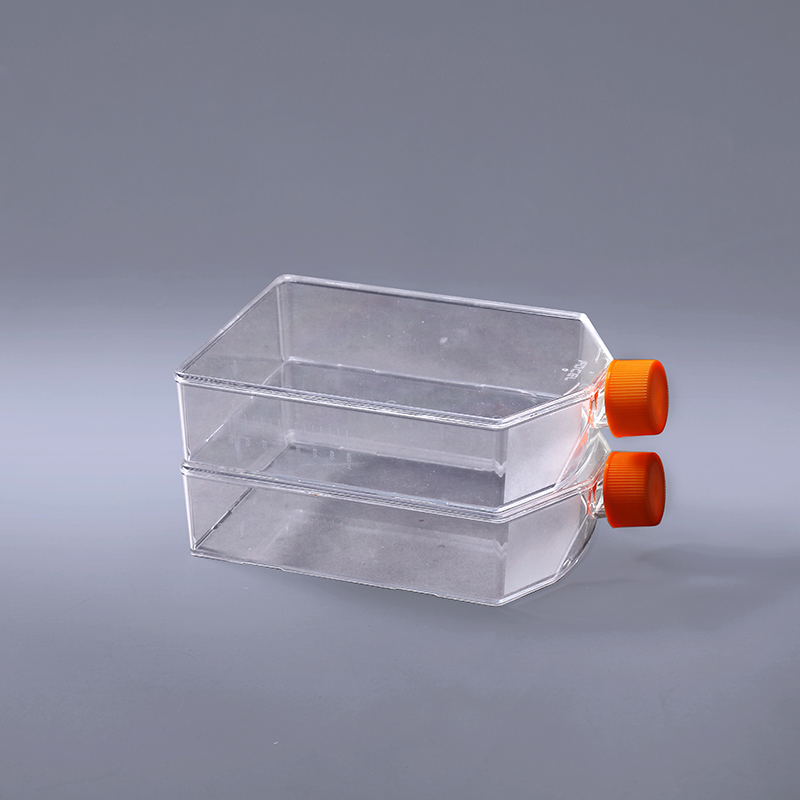je vyrobený z medicínskeho polystyrénového materiálu s vysokou transparentnosťou. Podľa rôznych procesov povrchovej úpravy sa delí na dva typy: hydrofilné a hydrofóbne. Bunkové kultivačné banky Fľaša s hydrofóbnou kultúrou buniek : používajú sa na kultiváciu adherentných buniek. Rast takýchto buniek musí mať podporný povrch, ktorý sa môže pripojiť, a bunky môžu rásť a reprodukovať sa na tomto povrchu spoliehaním sa na faktory pripojenia, ktoré samy vylučujú alebo ktoré sú poskytnuté v kultivačnom médiu. Povrch fľaše prešiel špeciálnou úpravou pre zavedenie hydrofilných skupín. Účelom toho je zvýšiť priľnavosť povrchu fľaše, ktorá je vhodnejšia pre rast buniek. Fľaša na kultiváciu hydrofilných buniek: používa sa na kultiváciu suspenzných buniek. Rast týchto buniek nezávisí od povrchu podložky a rastú v suspenzii v kultivačnom médiu. Takéto bunky sa nazývajú suspenzné bunky. Ako napríklad lymfocyty. Polystyrén má vo všeobecnosti štruktúru od hlavy po chvost, hlavný reťazec je nasýtený uhlíkový reťazec a vedľajšia skupina je konjugovaný benzénový kruh, čo robí molekulárnu štruktúru nepravidelnou, zvyšuje tuhosť molekuly a robí PS ne kryštalický lineárny polymér. Má určitý stupeň hydrofóbnosti, takže povrch možno použiť na suspenznú kultiváciu buniek bez špeciálnej úpravy.
Hydrophilic cell culture flask Vyššie uvedené sú dva typy baniek na kultiváciu buniek, ktoré sú vhodné hlavne pre stredné veľkosti bunkovej a tkanivovej kultúry v laboratóriu. Dizajn so širokým hrdlom uľahčuje kontakt pipety a škrabky na bunky s rastovým povrchom.
Hydrophobic cell culture flask: used for the cultivation of suspension cells. The growth of these cells does not depend on the surface of the support and grows in suspension in the culture medium. Such cells are called suspension cells. Such as lymphocytes. Polystyrene generally has a head-to-tail structure, the main chain is a saturated carbon chain, and the side group is a conjugated benzene ring, which makes the molecular structure irregular, increases the rigidity of the molecule, and makes PS a non-crystalline linear polymer. It has a certain degree of hydrophobicity, so the surface can be used for suspension cell culture without special treatment.
The above are two types of cell culture flasks, which are mainly suitable for medium-scale cell and tissue culture in the laboratory. The wide bottleneck design facilitates the pipette and cell scraper to contact the growth surface.
The FAI climbed 5.9 percent year-on-year in the first 11 months of 2018, quickening from the 5.7-percent growth in Jan-Oct, the National Bureau of Statistics (NBS) said Friday in an online statement.
The key indicator of investment, dubbed a major growth driver, hit the bottom in August and has since started to rebound steadily.
In the face of emerging economic challenges home and abroad, China has stepped up efforts to stabilize investment, in particular rolling out measures to motivate private investors and channel funds into infrastructure.
Friday's data showed private investment, accounting for more than 60 percent of the total FAI, expanded by a brisk 8.7 percent.
NBS spokesperson Mao Shengyong said funds into weak economic links registered rapid increases as investment in environmental protection and agriculture jumped 42 percent and 12.5 percent respectively, much faster than the average.
In breakdown, investment in high-tech and equipment manufacturing remained vigorous with 16.1-percent and 11.6-percent increases respectively in the first 11 months. Infrastructure investment gained 3.7 percent, staying flat. Investment in property development rose 9.7 percent, also unchanged.
 English
English



















































